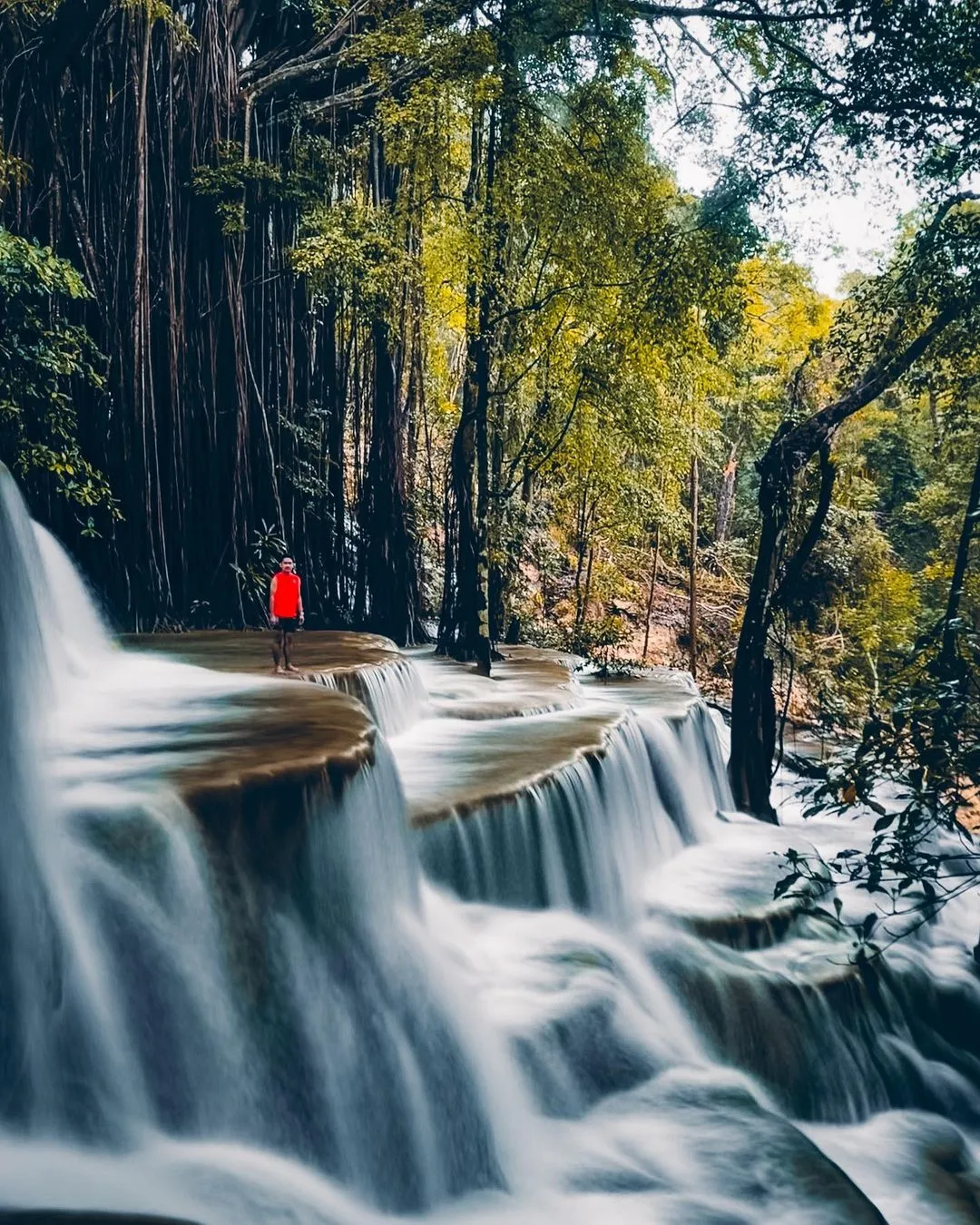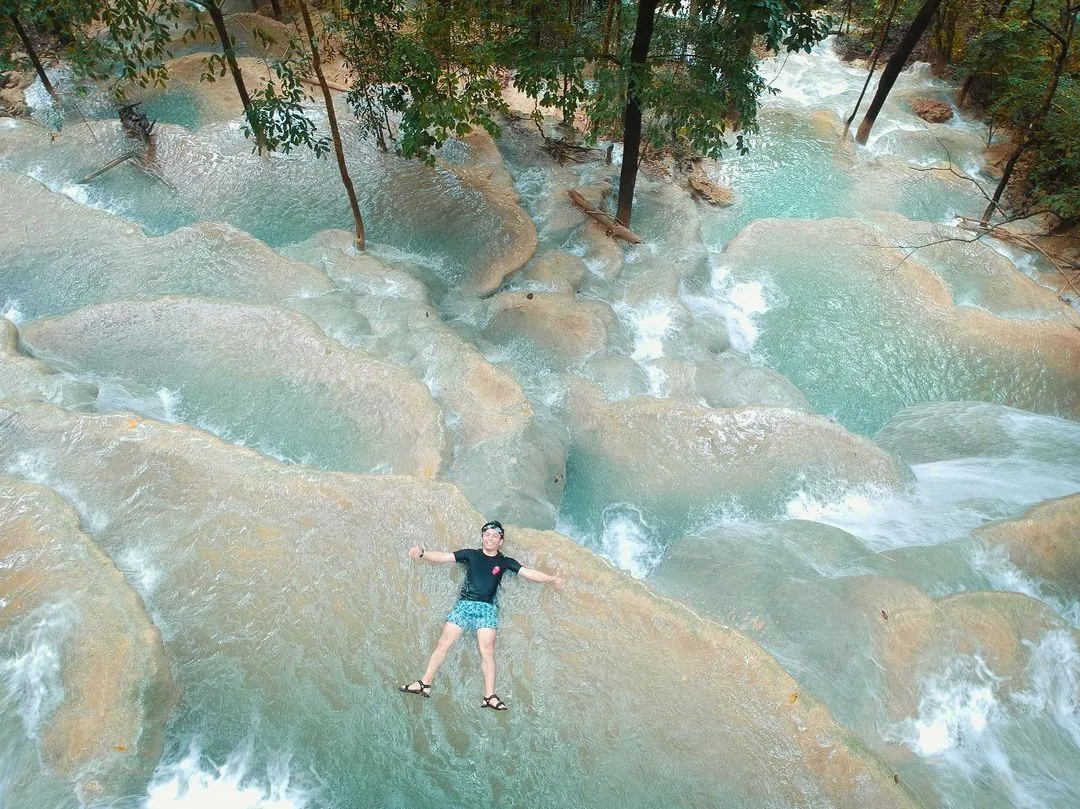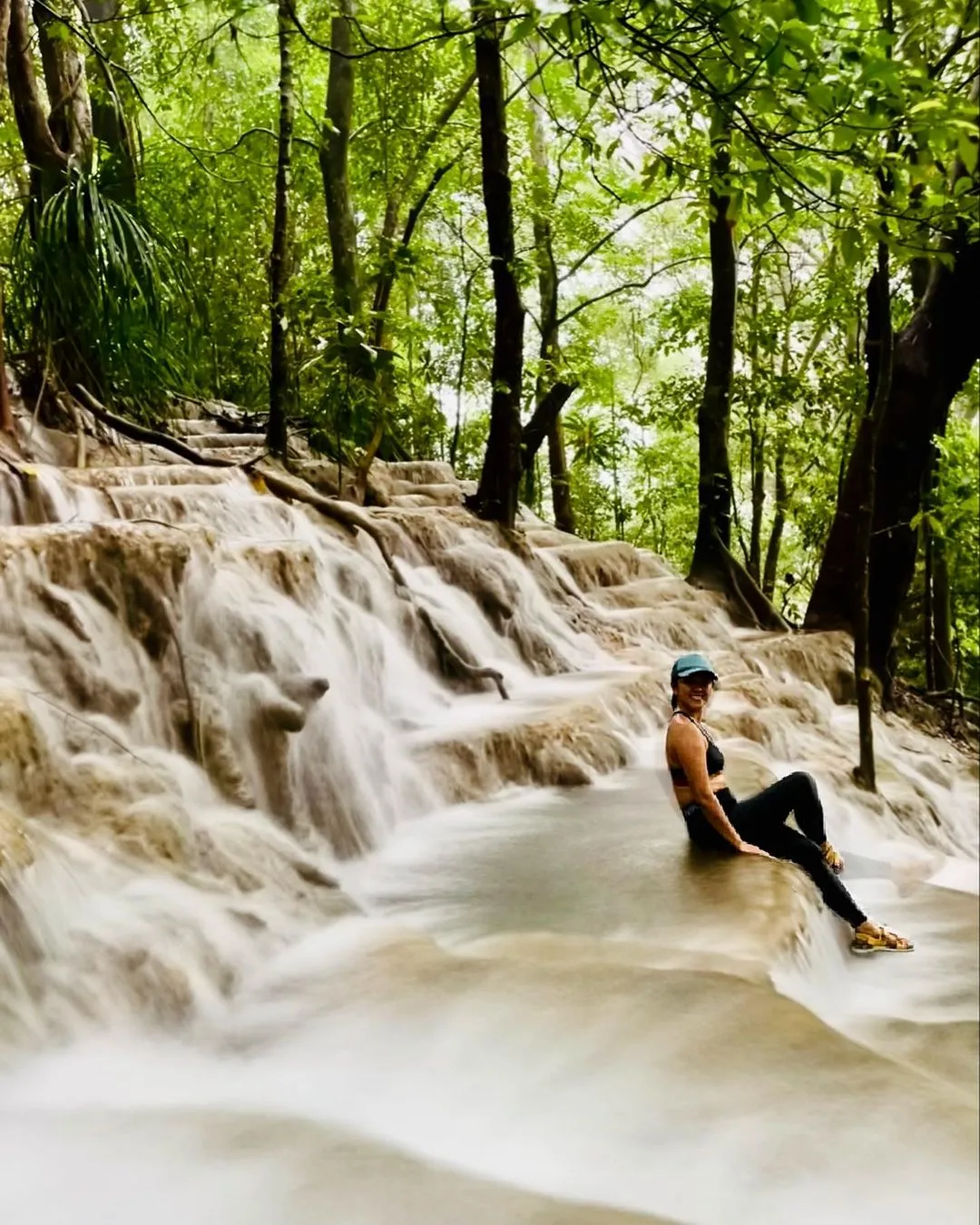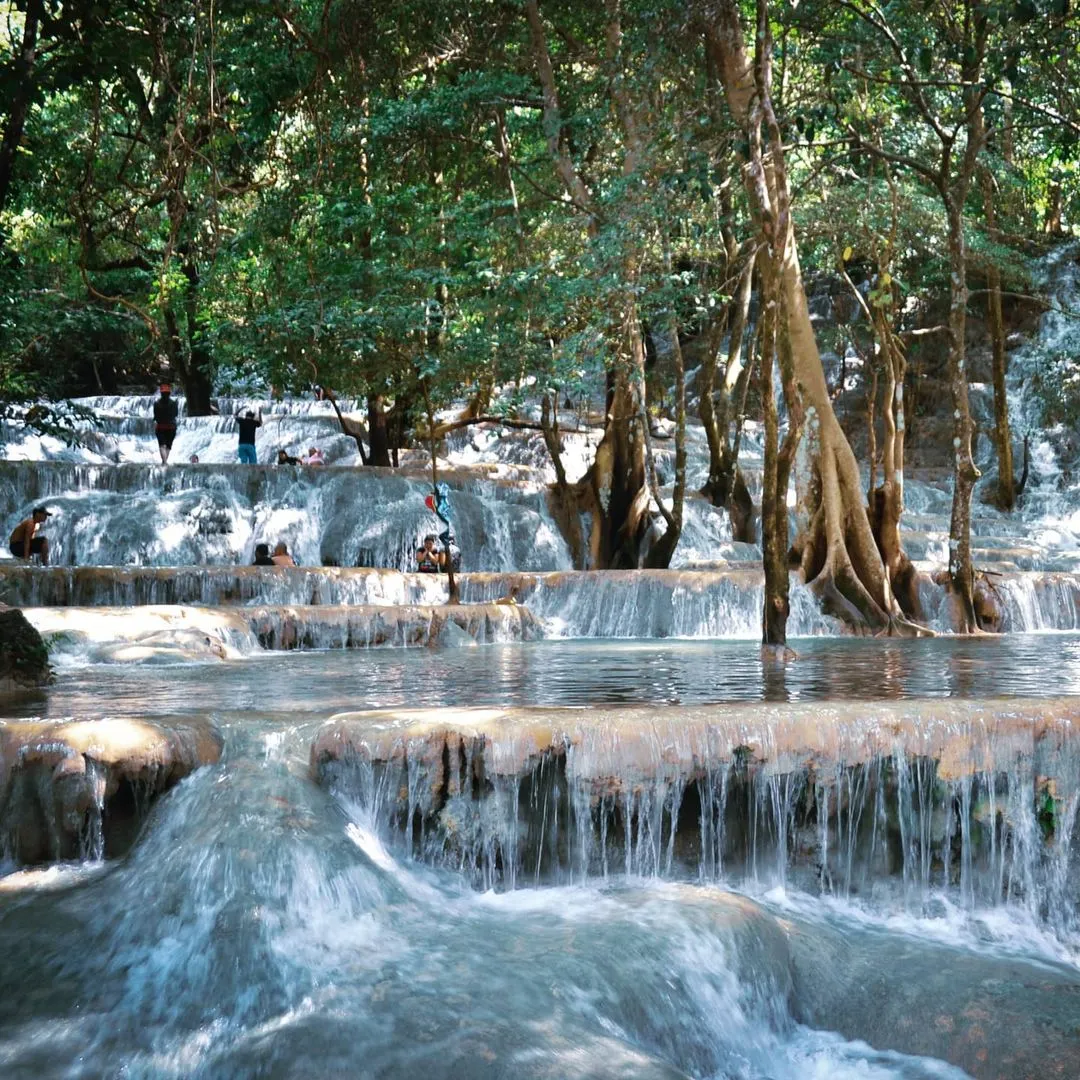
Kaparkan Falls: A Hidden Paradise in Abra’s Wilderness
Nestled in the rugged landscapes of Tineg, Abra, Kaparkan Falls is a breathtaking natural wonder that has captivated travelers with its multi-tiered travertine formations and stunning cascades. Unlike conventional waterfalls that plummet from great heights, Kaparkan Falls Abra flows over a vast stretch of terraced limestone, forming crystal-clear pools that shimmer under the sunlight. During the rainy season, the cascading waters enhance the natural beauty of the falls, making it one of the most mesmerizing destinations in the Philippines.
A Must-Visit Destination for Adventure Seekers
For nature lovers and adventure enthusiasts, Kaparkan Falls Tineg Abra offers an unforgettable experience. Its remote location, accessible only through a thrilling 4×4 ride, makes it an exclusive gem for those seeking off-the-beaten-path adventures. Every visitor who braves the journey is rewarded with unspoiled natural beauty, where the water’s gentle descent over terraces creates an almost surreal landscape—often compared to Pamukkale in Turkey. However, unlike its Turkish counterpart, Abra Kaparkan Falls is surrounded by lush tropical forests, adding to its untamed charm.
Kaparkan Falls Location and Seasonal Beauty
Kaparkan Falls location is deep within the mountains of Abra, approximately 45 kilometers from Bangued, the province’s capital. It remains seasonal, meaning that it only reaches its full glory during the rainy months (August to September). During this period, the terraces fill with gushing water, creating a natural infinity pool effect. However, during the dry season (March to June), Kaparkan Falls may run dry, making it less spectacular for visitors.
What You’ll Learn in This Travel Guide
If you’re planning a trip to Kaparkan Falls Abra, this blog covers everything you need to know, including:
- Kaparkan Falls photos that showcase its stunning beauty.
- Kaparkan Falls entrance fee and necessary permits.
- How to go to Kaparkan Falls from Manila, including transport options.
- Essential Kaparkan Falls travel tips for first-time visitors.
- The best time to visit and things to bring for a safe and enjoyable trip.
Join me as I uncover everything about this hidden paradise, ensuring you have the best travel experience possible!
Table of Contents
Where is Kaparkan Falls? (Location & Overview)
Kaparkan Falls Location: A Remote Hidden Gem in Abra
Kaparkan Falls location is deep within the municipality of Tineg, Abra, specifically in Sitio Kaparkan, Barangay Caganayan. This stunning natural wonder is nestled in the rugged mountains of Abra, a province in the Cordillera Administrative Region (CAR), Northern Philippines. Known for its isolated beauty, Kaparkan Falls remains one of the most breathtaking yet least accessible waterfalls in the country.
Due to its unique terraced rock formations, the falls are often mistaken for man-made infinity pools. However, these multi-tiered travertine terraces have been shaped naturally over centuries by mineral-rich waters, similar to the famous Pamukkale in Turkey. The pools reflect vibrant shades of blue and green, making them a spectacular sight, especially during the rainy season when the falls are in full flow.
Distance from Bangued and the Journey to Kaparkan Falls
Reaching Kaparkan Falls Tineg Abra requires a multi-leg journey. From Bangued, the capital of Abra, the falls are approximately 45 kilometers away. However, the challenging terrain and remote location make the trip a true adventure.
To get there, visitors must first travel to Bangued, where Kaparkan Falls tours are arranged. From the town proper, tourists must register with the local tourism office before embarking on a three-hour 4×4 “monster truck” ride through muddy and rugged mountain roads. This bumpy ride, often described as a “rollercoaster on wheels,” is a thrill in itself. The final leg of the journey involves a 10-20 minute trek down a forest trail leading to the magnificent cascading terraces of Kaparkan Falls.
Also Known as Mulawin Falls
Kaparkan Falls is sometimes referred to as Mulawin Falls because of the abundance of Mulawin trees in the surrounding forests. These trees, native to the Philippines, add to the untouched and pristine environment of the falls, making it a perfect escape for nature lovers.
Why Kaparkan Falls is Special
- Unique Limestone Terraces – Unlike conventional waterfalls, Kaparkan Falls features naturally formed multi-tiered travertine pools.
- Vibrant Blue Pools – The water’s distinct blue-green color is due to its high mineral content, making it visually stunning.
- Seasonal Beauty – The falls are only fully flowing during the rainy season (August-September), making it a rare and exclusive sight.
- Remote Location – The challenging journey to Kaparkan Falls adds to its adventurous appeal.
Find Kaparkan Falls on the Map
To help visitors navigate, here is the Google Maps location of Kaparkan Falls Abra: Kaparkan Falls Location on Google Maps
By taking on the journey to Kaparkan Falls Tineg Abra, you’ll be rewarded with one of the most unique and awe-inspiring waterfalls in the Philippines.

Best Time to Visit Kaparkan Falls
Kaparkan Falls at Its Best: August to September
The best month to visit Kaparkan Falls is August to September, during the peak of the rainy season in the Philippines. During this time, Kaparkan Falls Abra reaches its fullest and most breathtaking state, with water gushing down its terraced limestone formations, creating a mesmerizing cascading effect. The pools are crystal-clear and vibrant blue, making them perfect for swimming and photography.
Because Kaparkan Falls Tineg Abra is a seasonal waterfall, it does not flow year-round. This makes timing your visit crucial to experiencing its full beauty. Travelers who visit between August and September will get to witness the falls at their most majestic.
Avoid Visiting During the Dry Season (March to June)
From March to June, Kaparkan Falls dries up, leaving behind rocky limestone terraces with little to no water flow. While the formations themselves remain stunning, the experience loses its magic without the rushing water filling the natural pools. This is why visiting Kaparkan Falls during the dry season is not recommended—the long and challenging journey will not be worth it if the falls are not in their prime state.
Unpredictable Water Levels from October to February
If you plan to visit between October and February, be prepared for unpredictable water levels. While October may still have strong water flow, the later months can bring varying conditions. Some years, Kaparkan Falls retains its beauty until November, while in other years, the water levels drop sooner. If you’re planning a trip during this period, it’s best to check local weather conditions and consult local tour operators before finalizing your plans.
Weather Conditions and Safety Tips
Since Kaparkan Falls Abra is located in a mountainous region, the weather can be unpredictable and challenging, especially during the rainy season. Here are some important safety tips to keep in mind:
- Avoid visiting during heavy rains – The roads to Kaparkan Falls location become extremely muddy and slippery, making the 4×4 ride more dangerous.
- Check the weather forecast – Sudden downpours can cause landslides and flash floods in some areas of Abra.
- Wear proper footwear – The limestone terraces can be slippery, especially when wet. Non-slip trekking sandals or aqua shoes are recommended.
- Book a tour in advance – Since the best time to visit Kaparkan Falls is limited to a few months, slots for tours fill up quickly. Secure your booking ahead of time.
By planning your trip during the peak season (August-September) and following these safety precautions, you’ll get to witness Kaparkan Falls Abra in its most magnificent state, ensuring a memorable and worthwhile adventure.

How to Get to Kaparkan Falls: A Complete Travel Guide
How to Go to Kaparkan Falls from Manila
Visiting Kaparkan Falls Abra requires a combination of long-distance travel, off-road adventure, and a short trek. Due to its remote location in Tineg, Abra, getting there involves multiple transportation options. Here are the best ways to reach Kaparkan Falls location from Manila:
Option 1: Bus from Manila to Bangued, Abra (Most Affordable Option)
- Duration: 9-10 hours
- Cost: PHP 700 – PHP 1,200 (one-way, depending on bus class)
- Bus Companies: Partas, Viron, Dominion, and Victory Liner operate overnight buses from Cubao, Pasay, or Sampaloc to Bangued, Abra.
- Best for: Budget travelers and those who prefer public transportation.
Option 2: Private Car (Self-Drive) (Shorter Travel Time but Challenging Roads)
- Duration: 7-9 hours (depending on road conditions)
- Route: Take NLEX – SCTEX – TPLEX – McArthur Highway – Abra-Kalinga Road to Bangued, Abra.
- Challenges: Rough roads, steep inclines, and unpredictable weather conditions.
- Best for: Experienced drivers who prefer flexibility and convenience.
Option 3: Flight to Laoag/Vigan + Land Travel (Faster but More Expensive)
- Duration: 1-hour flight + 3-4 hours land travel
- Airlines: Philippine Airlines and Cebu Pacific fly from Manila to Laoag or Vigan.
- From Laoag or Vigan, take a bus or private van to Bangued, Abra.
- Best for: Travelers who want a faster but more expensive alternative.
From Bangued to Kaparkan Falls Tineg Abra
Once you arrive in Bangued, Abra, the adventure to Kaparkan Falls Tineg Abra begins. Here’s a step-by-step guide on what to do next:
1. Register at the DENR Tourism Office in Bangued
- Upon arrival, visitors must register at the Department of Environment and Natural Resources (DENR) Tourism Office in Bangued before proceeding to the falls.
- Registration ensures visitor safety and environmental preservation.
- Kaparkan Falls entrance fee and tour fees are settled here.
2. Take a 3-Hour 4×4 “Monster Truck” Ride
- Due to Kaparkan Falls location in the mountains of Tineg, Abra, the only way to reach it is via a 4×4 “monster truck.”
- Duration: 3 hours over steep, muddy, and rugged terrain.
- Experience: The ride is extremely bumpy and rough, often described as a rollercoaster on unpaved roads.
- Tours: Most travelers book Kaparkan Falls tours, which include the 4×4 ride, guide, and permits.
3. Trek 10-20 Minutes to Kaparkan Falls
- After the 4×4 ride, visitors must hike for 10-20 minutes to reach the falls.
- The trail is manageable, but it can be slippery, especially after rain.
- Proper trekking shoes or aqua shoes are recommended for safety.
Kaparkan Falls DIY vs. Guided Tour: Which is Better?
Kaparkan Falls DIY trips are extremely difficult due to the challenging roads, registration process, and environmental regulations. Here’s why joining a guided tour is the better option:
| Kaparkan Falls DIY | Kaparkan Falls Guided Tour |
|---|---|
| Must arrange your own transportation and permits. | Includes 4×4 transport, guide, and entrance fees. |
| No official tour guides to assist with navigation. | Guided by local experts familiar with the terrain. |
| Higher risk of getting lost or delayed. | Ensures a smooth and hassle-free experience. |
| No emergency assistance in case of accidents. | Safety measures and first-aid assistance available. |
For a stress-free experience, it is highly recommended to book a tour package with local operators like ABRAmazing Tours or coordinate with the Abra Tourism Office.
By planning your trip well and choosing the best transportation option, you’ll be one step closer to experiencing the breathtaking beauty of Kaparkan Falls Abra.

Kaparkan Falls Entrance Fees and Tour Packages
Kaparkan Falls Entrance Fee
Visiting Kaparkan Falls Abra requires payment of an environmental and maintenance fee, which helps in preserving its natural beauty. As of the latest information, the Kaparkan Falls entrance fee is PHP 300 per person. This fee is paid at the DENR Tourism Office in Bangued, Abra, before embarking on the journey to the falls.
Since fees are subject to change, it is always best to confirm with local tourism authorities before planning your trip.
Kaparkan Falls Tour Package Costs
Due to Kaparkan Falls location deep in the mountains of Tineg, Abra, visitors must take a guided tour that includes transportation via a 4×4 “monster truck.” The tour package cost typically ranges between:
- PHP 1,500 – PHP 2,500 per person
- Inclusions:
- 4×4 transport (round trip) from Bangued to Kaparkan Falls
- Local guide assistance
- Environmental and entrance fees
- Permit processing
Where to Book Tours for Kaparkan Falls
Visitors can book a Kaparkan Falls guided tour through the Abra Tourism Office or reputable tour operators such as ABRAmazing Tours. These agencies ensure a safe and well-organized trip, making it the best option for travelers.
For updated rates and Kaparkan Falls contact number, it is advisable to check:
- Abra Tourism Facebook Page
Discounts for Locals and Group Packages
Some tour operators may offer discounts for:
- Locals of Abra (must present valid ID)
- Large groups (5+ people)
- Early bird reservations during peak season
By booking in advance and choosing a reputable tour provider, visitors can enjoy a smooth and hassle-free adventure to Kaparkan Falls Tineg Abra.
Things to Do at Kaparkan Falls
A trip to Kaparkan Falls Abra is more than just a sightseeing experience—it’s an adventure into the untouched beauty of nature. From swimming in the natural pools to capturing breathtaking photography, Kaparkan Falls location offers plenty of activities that make the long journey worthwhile. Here are some of the best things to do at Kaparkan Falls Tineg Abra.
1. Swim in the Natural Pools
One of the main highlights of Kaparkan Falls is its natural limestone terraces, where crystal-clear waters create multiple natural infinity pools. These pools are perfect for swimming, especially during the rainy season (August to September) when Kaparkan Falls Abra is at its fullest. The mineral-rich waters have a distinct blue-green hue, offering a refreshing and unique swimming experience.
Swimming Tips:
- The best time to swim is early in the morning or late in the afternoon when the water is cooler.
- Wear water shoes for better grip on the limestone terraces, as they can be slippery.
- Observe safety precautions—some pools are shallow while others are deeper than they appear.
2. Capture Stunning Kaparkan Falls Photos
For photography enthusiasts, Kaparkan Falls location offers countless picture-perfect spots. The tiered pools, lush green surroundings, and cascading waterfalls make it a photographer’s dream. Whether you’re a professional or simply want to take Instagram-worthy shots, you’ll find plenty of angles to capture the falls’ breathtaking beauty.
Best Photography Spots at Kaparkan Falls:
- The top view of the terraces – Capture the full extent of the multi-layered cascades.
- Close-up shots of the pools – Showcase the vibrant blue-green waters.
- Side angles of the limestone formations – Highlight the unique travertine terraces, similar to Pamukkale in Turkey.
3. Trekking & Nature Appreciation
Getting to Kaparkan Falls Tineg Abra requires a short 10-20 minute trek from the drop-off point. This trail is surrounded by lush forests and diverse flora and fauna, making it a great opportunity for nature appreciation. Visitors can spot local plant species, towering trees, and small wildlife along the way.
Trekking Tips:
- Wear proper hiking shoes – The trail can be muddy and slippery.
- Bring a lightweight backpack – Keep your hands free for balance.
- Enjoy the journey – The trek itself is part of the Kaparkan Falls adventure.
4. Explore Nearby Attractions
Since reaching Kaparkan Falls Abra requires significant travel time, many visitors choose to include side trips to other must-see attractions in Abra. Here are some of the best places to visit near Kaparkan Falls location:
Abra River
- One of the largest rivers in Northern Luzon, known for scenic boat rides and pristine waters.
- Perfect for relaxing after a long day at Kaparkan Falls.
Piwek Rock Formation
- A unique limestone rock formation in Tineg, Abra.
- Offers a spectacular view of the Abra River and is great for rock climbing and photography.
Final Thoughts
Whether you’re here to swim in the natural pools, take amazing Kaparkan Falls photos, or explore nearby attractions, a visit to Kaparkan Falls Tineg Abra guarantees a one-of-a-kind experience. Make sure to plan your trip during the rainy season, follow Kaparkan Falls travel tips, and embrace the adventure!
Kaparkan Falls Travel Tips & What to Bring
Visiting Kaparkan Falls Abra is a one-of-a-kind adventure, but it requires proper preparation to ensure a safe and enjoyable experience. Due to Kaparkan Falls location in the remote mountains of Tineg, Abra, getting there is not as simple as visiting other tourist spots. The rough terrain, challenging 4×4 ride, and unpredictable weather make planning essential. Here are some important Kaparkan Falls travel tips and a checklist of what to bring.
Kaparkan Falls Travel Tips
1. Prepare for the Rough 4×4 Ride
- The journey to Kaparkan Falls Tineg Abra requires a three-hour ride on a 4×4 “monster truck.”
- Expect bumpy, muddy, and slippery roads, especially during the rainy season (August-September).
- Bring motion sickness medication if you’re prone to dizziness during off-road trips.
2. Book Your Trip in Advance
- Kaparkan Falls DIY trips are challenging due to the strict registration process and rough roads.
- It is highly recommended to book a tour package with the Abra Tourism Office or a local tour operator.
- Tour slots are limited per day, so reserving in advance ensures a hassle-free trip.
3. No Food Allowed at the Falls
- To preserve the natural beauty of Kaparkan Falls location, eating is not allowed near the terraces.
- Visitors may eat at designated picnic areas near the entrance.
4. Follow Local Regulations & Safety Guidelines
- Swimming is allowed in designated pools but avoid deep areas with strong currents.
- Respect the “Leave No Trace” principle—do not litter or disturb the natural environment.
What to Bring to Kaparkan Falls
To make the most of your trip, here are some essential items you should pack:
1. Proper Clothing & Footwear
- Wear lightweight, breathable clothing suitable for trekking and swimming.
- Bring non-slip water shoes or trekking sandals to safely walk on Kaparkan Falls’ limestone terraces.
2. Essentials for Outdoor Travel
- Waterproof bag to protect valuables.
- Sunscreen and insect repellent to protect against sun exposure and mosquito bites.
- Light snacks and bottled water (keep them in your bag until reaching the picnic area).
3. Camera & Phone for Kaparkan Falls Photos
- The stunning limestone terraces and crystal-clear pools make for perfect Kaparkan Falls photos.
- Bring a waterproof phone pouch or a GoPro to capture the best moments.
By following these Kaparkan Falls travel tips and packing wisely, you can ensure a safe, comfortable, and unforgettable visit to one of Abra’s most stunning natural attractions.
Where to Stay Near Kaparkan Falls
Accommodations in Bangued, Abra
Since Kaparkan Falls Abra is located in Tineg, Abra, deep within a mountainous region, there are no accommodations on-site. Visitors typically stay in Bangued, the capital of Abra, which serves as the jump-off point for Kaparkan Falls tours. Bangued offers a variety of hotels, resorts, and homestays, catering to different budgets and travel preferences.
Recommended Hotels Near Kaparkan Falls Abra
1. Abra Valley Grand Hotel (Budget Option)
- Best for: Backpackers and budget travelers.
- Features: Basic air-conditioned rooms, Wi-Fi, and a restaurant.
- Location: Located in the town center, close to transportation hubs.
2. Strutz Art Garden Resort (Mid-Range, Nature-Inspired Stay)
- Best for: Travelers looking for a relaxing and scenic accommodation.
- Features: Lush gardens, spacious rooms, and a peaceful atmosphere.
- Location: Situated a few minutes from Bangued town proper.
3. Tineg Farm Lodges & Homestays (Local Experience, Close to the Jump-Off Point)
- Best for: Those who prefer an immersive, local experience.
- Features: Traditional Filipino hospitality, farm stays, and home-cooked meals.
- Location: Closer to the Kaparkan Falls jump-off point.
Camping at Kaparkan Falls Is Not Allowed
For conservation purposes, camping near Kaparkan Falls location is strictly prohibited. Visitors are encouraged to stay in Bangued and take a day trip to the falls via an organized tour.
Booking accommodations in advance ensures a comfortable and well-organized trip, making your Kaparkan Falls adventure smooth and hassle-free.
FAQs About Kaparkan Falls
Planning a trip to Kaparkan Falls Abra? Here are some frequently asked questions to help you prepare for your adventure.
1. What is the best month to visit Kaparkan Falls?
The best month to visit Kaparkan Falls is August to September, during the rainy season. This is when the water levels are at their highest, making the terraced waterfalls more stunning. Avoid visiting during the dry months (March to June) as Kaparkan Falls location may not have enough water flow.
2. How much is the Kaparkan Falls entrance fee?
The Kaparkan Falls entrance fee is PHP 300 per person. This fee is paid at the DENR Tourism Office in Bangued, Abra before proceeding to the falls.
3. Can I visit Kaparkan Falls DIY?
A Kaparkan Falls DIY trip is not recommended due to the rough terrain and the mandatory use of a 4×4 vehicle to reach the falls. It is best to book a guided tour to ensure a smooth and safe visit.
4. Is Kaparkan Falls safe for kids?
Yes, Kaparkan Falls Abra is safe for kids, but parental supervision is required due to slippery limestone formations and varying pool depths.
5. Can I bring food inside Kaparkan Falls?
No, eating is not allowed near the falls to help preserve the environment. Visitors can eat at designated picnic areas near the entrance.
6. How to go to Kaparkan Falls from Manila?
To reach Kaparkan Falls from Manila, take a bus or private car to Bangued, Abra. From there, register at the DENR Tourism Office and take a three-hour 4×4 ride, followed by a short trek to the falls.
7. Is there a Kaparkan Falls contact number?
For Kaparkan Falls contact numbers, check with the Abra Tourism Office or local tour operators such as ABRAmazing Tours for updated details.
By keeping these FAQs in mind, you can better plan your Kaparkan Falls adventure and enjoy a hassle-free trip to one of the most breathtaking waterfalls in the Philippines.
Conclusion: Experience the Natural Wonder of Kaparkan Falls
A visit to Kaparkan Falls Abra is more than just a getaway—it is a journey into one of the most breathtaking natural landscapes in the Philippines. The multi-tiered travertine pools, crystal-clear waters, and lush surroundings create an unparalleled experience for nature lovers and adventure seekers alike. Whether you’re looking to swim in the natural pools, capture stunning Kaparkan Falls photos, or simply admire its untouched beauty, this hidden paradise will leave you in awe.
To make the most of your visit, plan your trip during the best time to visit Kaparkan Falls (August-September) when the waterfalls are at their fullest. Since Kaparkan Falls location is remote and requires a challenging 4×4 ride, it is highly recommended to book a guided tour to ensure a safe and seamless adventure.
Have you visited Kaparkan Falls Tineg Abra? We’d love to hear about your experience! Share your travel stories and Kaparkan Falls photos in the comments below. Don’t forget to spread the word by sharing this guide with fellow travelers.
For more Philippines travel guides, follow this blog and stay updated with the best travel tips, itineraries, and adventure destinations. Start planning your Kaparkan Falls adventure today!



Could you try to contact the LGU of Tineg, Abra? https://www.facebook.com/profile.php?id=100085470035872
Pingback: Kaparkan Falls: A Majestic Stairway to Heaven in Abra
Pingback: Kaparkan Falls: A Majestic Stairway to Heaven in Abra
Pingback: Discovering Kaparkan Falls and Malapascua Island | Travel Guide -
Pingback: Kaparkan Falls in Abra | 2024 Travel Guide Philippines
This travel blog is incredibly informative and well-researched, offering valuable tips and insights for both first-time and seasoned travelers. The detailed itineraries and personal experiences make it easy to plan trips with confidence. Anyways, do you have any food recommendation on the nearby area?